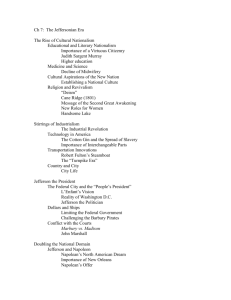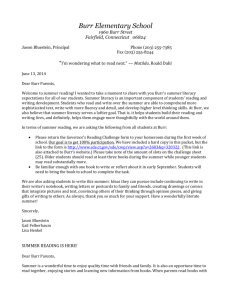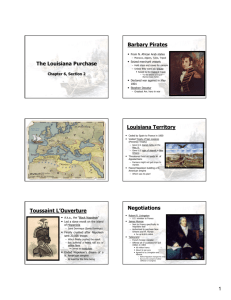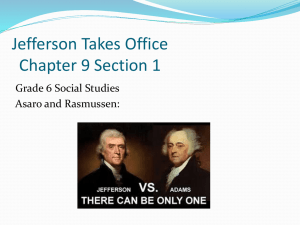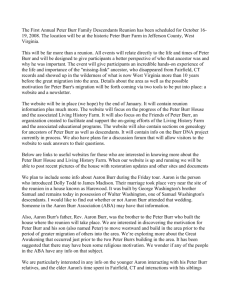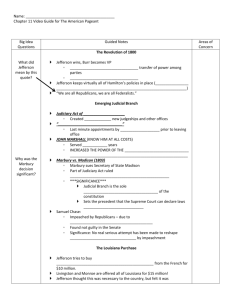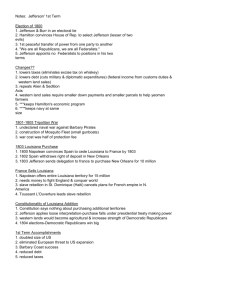Reliving History, Inc. Facts about the Peter Burr House (PBH)
advertisement
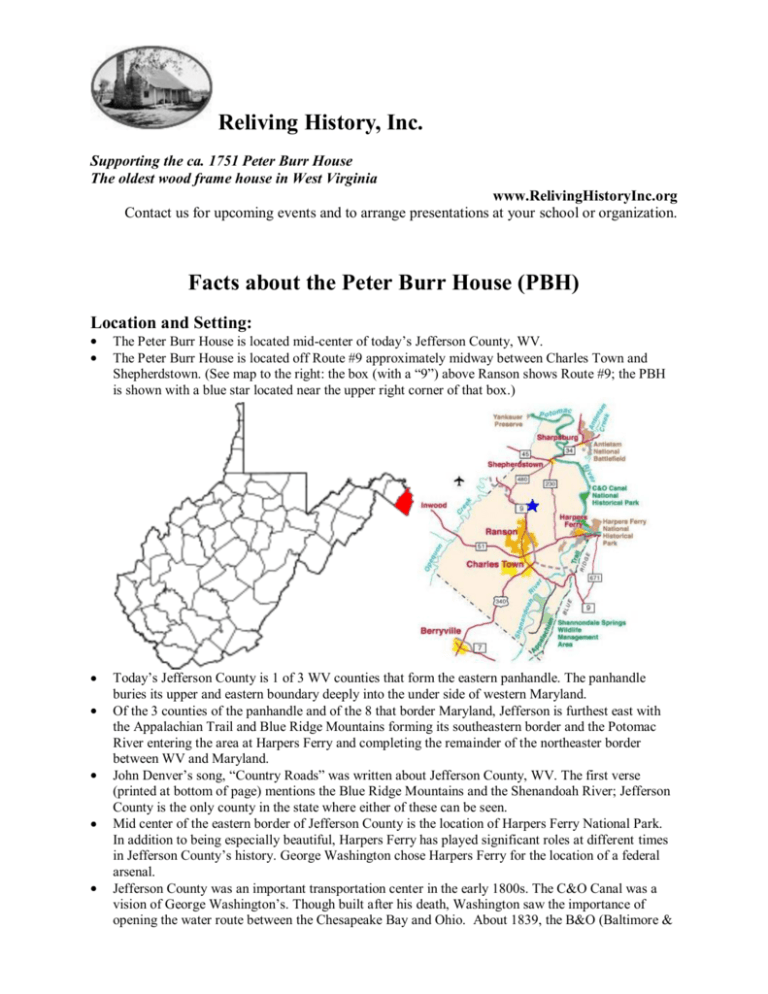
Reliving History, Inc. Supporting the ca. 1751 Peter Burr House The oldest wood frame house in West Virginia www.RelivingHistoryInc.org Contact us for upcoming events and to arrange presentations at your school or organization. Facts about the Peter Burr House (PBH) Location and Setting: The Peter Burr House is located mid-center of today’s Jefferson County, WV. The Peter Burr House is located off Route #9 approximately midway between Charles Town and Shepherdstown. (See map to the right: the box (with a “9”) above Ranson shows Route #9; the PBH is shown with a blue star located near the upper right corner of that box.) Today’s Jefferson County is 1 of 3 WV counties that form the eastern panhandle. The panhandle buries its upper and eastern boundary deeply into the under side of western Maryland. Of the 3 counties of the panhandle and of the 8 that border Maryland, Jefferson is furthest east with the Appalachian Trail and Blue Ridge Mountains forming its southeastern border and the Potomac River entering the area at Harpers Ferry and completing the remainder of the northeaster border between WV and Maryland. John Denver’s song, “Country Roads” was written about Jefferson County, WV. The first verse (printed at bottom of page) mentions the Blue Ridge Mountains and the Shenandoah River; Jefferson County is the only county in the state where either of these can be seen. Mid center of the eastern border of Jefferson County is the location of Harpers Ferry National Park. In addition to being especially beautiful, Harpers Ferry has played significant roles at different times in Jefferson County’s history. George Washington chose Harpers Ferry for the location of a federal arsenal. Jefferson County was an important transportation center in the early 1800s. The C&O Canal was a vision of George Washington’s. Though built after his death, Washington saw the importance of opening the water route between the Chesapeake Bay and Ohio. About 1839, the B&O (Baltimore & Ohio) railroad was built through a wooded area on a 110 acre tract through Peter Burr’s old property within a few yards of the PBH. Several major battles of the Civil War took place in Jefferson County especially in areas between Harpers Ferry and Shepherdstown, which is a short distance across the Potomac from Sharpsburg and Antietam Battle Field. The B&O Railroad and the C&O Canal were especially of value to the troops on both sides. The PBH with its proximity to Warm Springs Road and two railroads is considered to be along the pathway for Union and Confederate soldiers. During the trial of John Brown, Moses W Burr, (via Peter Burr’s son James) served as a magistrate for Charles Town. In 1920, Senator Milton Burr (another direct descendant of Peter Burr) cast an important vote for Women’s Suffrage in the US. He received a personal message from President Woodrow Wilson and soon thereafter cast a key vote that led to the ratification of the Nineteen Amendment. When Peter Burr came to the area, the territory was part of a large section that was then part of Frederick County in the Colony of Virginia Note: As settlements grew, county lines were redrawn at least 4 times in 80 years. Today’s Jefferson Co, WV, was first included in: Spotsylvania Co, Virginia Colony (1721) Orange Co, Virginia Colony (1734) Frederick Co, Virginia Colony (21 Dec 1738) – Winchester was center of government Berkeley Co, Virginia Colony (Feb 1772) 1772 – Martinsburg was center of government Jefferson Co, in the state of Virginia (08 Jan 1801) – Charles Town was center of government Jefferson Co, West Virginia 1863 (when West Virginia withdrew from the state of Virginia) The Peter Burr House (PBH) The ca. 1751 PBH today is the oldest wood frame structure in the state of WV; it has also outsurvived all wood frame houses of the Chesapeake Bay area and the Tidewater plantation area of the Colony of Virginia Enlargements of the house occurred about 1770s and again about 1800-1820. No other structural changes have occurred in about 200 years PBH (with an adjacent spring house) was listed on the National Register of Historic Places in 1981 by the West Virginia Division of Culture and History. The historic significance of the PBH: 1) It is one of less than a dozen structures in the state that survive from the pre-1760 period; 2) It is associated with the prominent Burr family; 3) It is an extremely rare example of an early settlement homestead; 4) It indicates the presence of significant archaeological deposits on the site of the house. Of the 5 other pre-1760 structures in Jefferson County, all are stone or partially stone and are more representative of the manor house or large estate-oriented building. Peter Burr Sr. and Jr. arrived in the area about 1748, only twenty years after the arrival of the first white settlers in the area, and built the existing house about 1751. Of major significance for the time and location: the original section of the PBH (all of which still remain relatively unchanged) was constructed with two rooms downstairs and two rooms upstairs. During the 1600s and early 1700s, most houses constructed in America were of the hall/parlor plan. While occasionally entry into the house was through a small porch or entryway, typically access into the house was directly into a room, often referred to as a hall. The PBH was built according to this plan. According to medieval (not modern) usage, the hall operated as the center of household activity. Cooking, eating, reading, conversation and often sleeping all occurred in this one room and in many houses, it was the only room of the house. Some houses contained two rooms; the hall and the parlor or chamber, which entered from the hall. The chamber often contained the best in household goods and occasionally functioned as a room for visiting guests as well as a sleeping chamber. Between 1721-1730: 27 of Virginia's 34 wealthiest individuals (primarily in the Tidewater area near the Chesapeake) lived in houses with only 2 ground-floor rooms, while 2 individuals lived in houses with only 1 main room. These small houses sometimes had 1 or 2 rooms upstairs, typically referred to as chambers. While these rooms might contain some bedding, often the better bedsteads were kept in the downstairs rooms, while the upstairs rooms could serve as storage for everything from tools to food. These houses were small and built of post in the ground construction. None remain in the Chesapeake region. Since the posts and often the sills supporting these buildings sat directly in the dirt, most of these buildings rotted away before they could be used by a second generation of settlers. All of this makes the PBH an even more unique survivor of early settlement in Jefferson County The remarkable significance of this building in the area of the Virginia Colony has been recognized by the editors of a pictorial guide to the historic sites of the state, who listed the PBH immediately after Harpers Ferry as one of the most significant historic buildings in the county as well as by the National Park Service, who completed an Historic American Building Survey (HABS) on the buildings in 1983. The similarity of the PBH to other frame structures of New England has long been noted. This similarity also contributes to the preservation of this building when so many other early Virginia structures, built with posts in the ground, have deteriorated and no longer exist. Reconstruction work required on the east wall provided the opportunity to examine the framing of the building. The corner posts of the building and the sills are on a small but effective stone foundation of several courses. The framing is similar to that identified … as evolving by 1700 from earlier forms in New England. While the steep pitch of the PBH has long been associated with its New England antecedents, this illustration indicates the changes in framing which occurred to create more head room in the second floor rear room. The first floor contained a brick and mortar infill, also often cited as another New England feature. While not unknown as a building technique in this region, its use is not common. The brick is hand-molded, and of various sizes Exposure of the east wall indicated that the infill of the second floor consisted of a lime and mud daub or mortar, while the steep attic pitch contained no infill of any sort. The large chimney of the older portion of the house, with its broad base and squat stack, is also reminiscent of the late 1600s buildings of New England Other building details, not obvious on a first inspection, are reflective of New England construction techniques. These include the use of purlins running on the exterior of the roof rafters to provide a surface for roofing materials. Wooden details, particularly the detailing on the exposed corner posts in the second floor rooms, the beading on the exposed joists on the first floor, and the beaded clapboard on the exterior are all often found in New England houses of the early 1700s. Preliminary examination of the house does appear to confirm that the eastern section is the original house. Containing four rooms, two upstairs and two down, the PBH was of a substantial size for a relatively new frontier settlement In 1730 in New England at least 40% of the population lived in a house with 3 rooms or less. While the use of the rooms in the PBH cannot be currently substantiated, it appears the southern room functioned as the hall described earlier was in fact the room where cooking, eating, conversation and some sleeping occurred. Reconstruction of the stone chimney in this room revealed a small opening that may have been a warming oven. It is clear that the middle section of the house was attached later; a pocket in the girt, a horizontal support timber of the main section, indicates the location of a vertical support timber, removed to create a doorway to the middle section. Early laws in Virginia required that the kitchen be a separate structure The importance of the PBH to the history of the settlement of Jefferson County cannot be disputed. The early date and nature of its construction make the PBH particularly well-suited to a study of vernacular architecture (architecture of common usage and communication). In other words, while buildings are built to serve as shelter, they also display what we think about ourselves and our role in society. Cultural 'messages' are encoded in the more modest homes of people living in the countryside. Buildings also 'learn' through time, altered to fit new circumstances as well as opinions. The PBH has been altered from its earliest, 1750s appearance. Peeling away these alterations can be likened to an archaeological excavation, with each layer related to a different period of time. Often, these changes reflect changing family circumstances rather than broadly defined historical events influenced by great men. For example: a long term fall in grain prices will have more effect on a regional economy than political decisions made in a nearby city. Individual houses grow and change through time, often related to a family's economic situation and household size and composition. For example: building changes often take place when a son takes over from his father as the head of the household. Beyond these individually oriented changes, most landholders building a house operate with similar notions of the appropriate materials to use in house construction, and the number and types of rooms a house should contain. This house "template" or pattern is shaped and sometimes altered by our common cultural heritage. Vernacular architectural historians of the Chesapeake and Virginia note the change in house construction that occurs around 1750, i.e. an increase in the use of the term 'dining room' to refer to one room, although it is clear by its furnishings that it is not set apart just for dining. The biggest change in some houses of the time is the addition of a passage, known today as “the hall.” The inclusion of this passage, as well as the differentiation of room use or function, became two standard features of houses as the eighteenth century drew to a close. Both were at a deeper level related to social relationships, and creating separate public and private spaces within the house. The passage was to serve as a place to meet guests, before determining what room to entertain them in. The PBH represents not only an earlier, different time, but a different way of looking at the world and of letting the world look at you. It is a way of life that no longer exists. Life in the House The PBH reflects a different culture than that of the gentry, yet his house reflects a uniqueness that set Peter Burr apart from other settlers in the area. Early settlers into the upper section of the Shenandoah Valley were primarily cultures from Pennsylvania and parts of New York. People of Puritan descent from New England were not common among the early settlers in this area. Peter Burr the Second … came to the county probably in the late 1740s from Fairfield, Connecticut His father, Peter Burr the First (born 1699) was an older brother of the Reverend Aaron Burr of Princeton, New Jersey. Vice-President Aaron Burr was the only son of the Reverend Burr, who was to become President of Princeton before his early demise in 1757. Motivation for migrating from Connecticut to this county - maybe because of the lure of land speculation; possibly the absence of hostile Indians, which were plentiful on the western CT/NY frontier Peter Burr acquired a grant from Lord Fairfax for 406 acres on which the house now stands in June of 1751, the house was probably built shortly before or after this date George Washington was known to travel up Warm Springs Road (which cut through Peter Burr’s property) on his was to sites north and west of the area Peter Burr would have taken his tobacco to the tobacco warehouse built about 1789 and still standing. The tobacco warehouse is the only building left on the Old Road to the Ferry. The remains of the Mecklenburg Tobacco Warehouse may be the oldest stone tobacco facility in present-day West Virginia. It is the only standing commercial building on the once busy Shepherdstown riverfront. James Madison married Dolly Madison at Samuel Washington’s house about 5 miles from the PBH (Dolly was introduced to Madison by Peter Burr’s cousin, Aaron Burr) Peter Burr and his two wives are buried in unknown graves believed to be on the first land grant; this raises questions as to whether or not PB buried his wives there because 1 or more family members may have been buried there before the land was sold in 1754 Peter Burr provided supplies to the Continental Army Peter Burr’s 13 children were born in this house; all but one married and had descendants The PBH and Spring House are listed on the National Register of Historic Places A family grave site exists nearby with the graves of two of Peter Burr’s children and their descendants Peter Burr the Second (born 1727) helped establish a Presbyterian church along Elk Branch near his home. Peter Burr, along with John Wright and Mesrs Tully, as trustees of the church, acquired one acre from John Engle and his wife in 1770. This congregation reportedly met in a small log church located about 1/2 mile west of the current Elk Branch church, inside a Block House. Philip Vickers Fithian, who served as a supply minister to Elk Branch in February of 1776, refers to "...a Settlement of my Countrymen. Mr Burr, Tully, Conklin, Boyd, Sayre, Garrison, with their Families, and others. dined at Mr. Burr's. He is a good-Liver, as it is commonly said. Appears to be a modest, sensible Man, & is in high Repute -- " Fithian spent one night during his stay at Mr. Burr's. Elk Branch Church failed by 1783 but was re-established in a new location about 1/2 mile east of the original location in 1830. 1787, Peter Burr was one of four grantees to a plot of ground for a Presbyterian church in Charles Town granted by Charles Washington There are also references to Peter Burr supplying provisions to the Berkeley County authorities during the Revolutionary War years. Peter Burr the Second died in 1795 and left his house and a portion of the original 406 acre grant to his oldest son, Peter Burr the third, born in 1764. This Peter Burr left the property in the hands of three trustees in 1799 and emigrated to Ohio. Historic Overview NOTE: as we get into vernacular architecture and cultural messages, understanding of the significances of some of the differences becomes important for understanding the times and the people. In the early 1600s England, it was illegal for anyone other than royalty or the “gentry” to wear ribbons, ruffles, and embellishments on their clothing. These frills were not part of the culture of those farther down on the hierarchy. In America, people who could afford embellishments flaunted them because they could. So, when one today enters the original section of the PBH and notices the hand beaded ceiling beams and chair rails and other signs of affluence, one wonders why on earth would they take the time and go to the trouble of adding such intricate detail in a house way out in the middle of the frontier. And the answer very simply is “because they could.” Such overstated and lavish details were found in abundance as one went up the hierarchy during the time because those who could . . . did. Early houses in the towns were built close to the walkways so that the entire depth of the lot could be cultivated, and still have room for appropriate outbuildings. As more provisions became available from local merchants new houses were built farther back on the lots to make space for porches, lawns and flower garden. These were marks of affluence. Early houses in Mecklenburg had to be at least 20’ wide, 17.5’ deep, 1 ½ stories high with a stone or brick chimney on one end. (One of the original houses, ca. 1750-1765 continues to exist on High Street in Shepherdstown.) Bright colored paints were expensive and wealthy people often painted the interiors of their homes in very bright or very dark paints to communicate they had such wealth. Conrad Shindler was a coppersmith in Mecklenburg in late 1790s Michael Rickard built his home which served also as his locksmith shop in 1795. His shop remained in his family for three generations and was later the shop where the screw lock, used as switch locks by railroads, was later invented. The handcuffs worn by John Brown at his trial in Charles Town (1859) were also crafted there. The building still exists in Shepherdstown. By 1775, Town Run was an area between Pack Horse Ford and today’s Shepherdstown where more than twenty natural springs before the Run enters the south end of town. It never floods, nor runs dry; it meanders through backyards, under houses, across alleys and beneath five streets. This setting was conducive to artisans. As a result, by 1775 the town boasted 1,000 inhabitants. Several operations – gristmills, sawmills, manufacturing mills and warehouses – were positioned in the ravine. Near the bottom of the hill a bridge spanned Town Run. The old road to the ferry was on the west side of Four important generals of the Revolutionary War made their homes in Berkeley County. These include Generals Horatio Gates, Charles Lee, Adam Stephen, and William Darke. Brigadier General Horatio Gates resided at "Traveler's Rest" near Peter Burr’s house slightly to the north, and General William Darke (also a member of Peter Burr’s church) lived slightly to the northeast of Burr’s property line. General Adam Stephen had earlier been a neighbor to the west as was Charles Lee. Burr could have walked to any of their houses with little effort. Major General William Darke (1736-1801) came to the Shepherdstown area about 1740 at age 4. He was 9 years younger than Peter Burr. The two men lived easily within walking distance, attended the same church, and were believed to have been friends as well as neighbors. Major General Adam Stephen (1721-1791) lived at “Bower Lodge” from 1753 to 1772. This property was near General Lee’s home and was within about 5 miles of PBH. Stephen, a surgeon and soldier, fought in the French and Indian War as well as the Revolutionary War. During the Revolutionary War, he became a general after he fought in the Battle of Trenton. Stephen was the largest landholder in the county and moved to a nearby piece of property shortly after Frederick County was divided and Berkeley County came into being. Stephen founded Martinsburg which became the county seat of the new Berkeley County. In 1774 he built a home in Martinsburg that has now been restored and furnished in its original time period. Peter Burr and other freemen able to vote went to Martinsburg to cast their votes. In 1788, Peter Burr and others elected Generals Darke and Stephen to represent Berkeley County in the Virginia Assembly where both voted to ratify the constitution. Horatio Gates (1727-1806) was General Washington's second in command of the Continental Army, and he came to disapprove of Washington’s leadership of the Continental Army. The New England contingent pressed their demands by openly suggesting General Gates as commander-in-chief. This position was supported by General Charles Lee and others. General Charles Lee (1732-1782), like Gates was a well-trained former British soldier. He had eccentric social behaviors, but at one time was considered for overall command of the entire Continental Army. After being taken prisoner at Basking Ridge, New Jersey and then rejoining the American Army after a year in captivity, General Lee maintained his reputation as a cantankerous critic of General George Washington. Such criticism, coupled with a supposedly ill advised, and unauthorized retreat at the battle of Monmouth eventually caused Lee to resign his commission after a court martial failed to clear his tainted name. “Prato Rio” estate of General Charles Lee (in present day Jefferson County) was known to locals as “The Hut” for its squat, unattractive appearance. The house itself had an odd layout, with no partitions or walls, only chalk lines drawn on the floors to distinguish specific “rooms,” – the sort of eccentric behavior one might expect from such a character. Brigadier General Daniel Morgan (1736-1802) an American pioneer, soldier, and United States Representative from Virginia, was one of the most gifted battlefield tacticians of the American Revolutionary War. On 14 Jul 1775, he recruited 96 men in ten days, assembled them, and marched them to Boston in 21 days. They arrived Aug 6 and became well known as Morgan’s Sharpshooters. After significant victories in battle, he returned home to Charles Town after the Revolutionary War and in 1782 joined the Presbyterian Church and built a home near Winchester, VA. He later commanded the troops that suppressed the Whiskey Rebellion. General George Washington (1732-1799) had offices in Winchester, south of today’s Jefferson County from 1748-1765 and frequented the area from time to time. He surveyed for Lord Fairfax in this area and had good knowledge of the area including main physical features. Generals Gates and Lee and Aaron Burr were all involved in efforts to remove General George Washington from command during the American Revolution. Washington relieved both Gates and Lee of their commands. Although no specific evidence has yet been found, these associations suggest that Peter Burr and some (if not many) of his neighbors may have been at odds with Washington family members who dominated the military, political, economic, and social arena of the time. The area that is now Jefferson County, WV did not see much activity during the French and Indian War. However several forts within 30-40 miles on either side did see major activity. Some skirmishes came much closer. Gruesome news reports were abundant by word of mouth and no doubt the settlers lived many of those years wondering about their safety. It is believed that the father and possibly the son were in the area by 1748 (when George Washington at age 16 was beginning to help survey the area for Lord Fairfax) Disputes existed at the time between Lord Fairfax and the Colony of Virginia as to ownership of the area. Lord Fairfax began issuing land grants in mid 1750; George Washington and family began purchasing thousands of acres in October 1750. Peter Burr (father and/or father and son) purchased two land grants in June and July 1751 totaling 886 acres. The PBH is built on the smaller of these two grants (406 acres) referred to as the Bardane property as opposed to the Halltown (480 acres) property. It appears that Peter Burr put thought into how he built his house. He selected an area at the headwaters of the Elk Branch that was low enough to not make the house conspicuous to Indians. Windows for his house face east to catch early morning light. Today’s Jefferson County, WV is part of over 5.2 million acres once known as the Northern Neck The area was originally owned by the Virginia Company 1624 – Ownership was taken over by the Crown 1649 – Charles II granted 7 royalist supporters the land "bounded by and within the heads" of the Potomac and Rappahannock Rivers (i.e. the over 5.2 million acres) 1649-1719 – In England, ownership of the land began passing down within the royal families 1649-1746 – In the Virginia Colony, the Northern Neck (later known as the Fairfax Grant) was an undefined area of Virginia. Partly because of the ill-defined property lines, this area came into dispute by Lord Fairfax and the Colony of Virginia. In the absence of the royal family, Virginia’s General Assembly had long retained political and legal authority over the Northern Neck and did not want to lose the authority to grant land and to collect fees from processing such grants in that area. In addition to rents, the Colony of VA wanted westward settlement of the frontier to expand land holdings especially for the Tidewater plantation owners. (An interesting note here concerns who the leaders of the Virginia Colony were at the time. Because the Anglican Church was the state church, then church leaders were the only ones who could hold political office. In Virginia, like in England, the governing body was also the heads of the church. The wealthy Tidewater plantation owners were the top church officials and therefore were also the government leaders. Tobacco was a lucrative cash crop for these wealthy officials and in great demand as a primary exported to England. However, tobacco farming strips nutrients from the land, and the plantation owners had to move their crops to new fields every few years. To continue to grow the cash crop in abundance, the wealthy land owners needed acquisition of new land holdings. There interest in settling the land was much greater than simple exploration.) The Government of Colonial Virginia wanted this wilderness settled as quickly as possible, as a buffer against Indians The Colony of VA offered incentives for settlers to settle the frontier; this began years before the Fairfax dispute over boundary lines was settled and these transactions set up conditions that would later (mid 1750s and later) lead to land disputes and the eviction of some settlers who had built homes, cleared, and worked prime lands. The Virginia government objected to ownership claims by the Culpeper and Fairfax families who lived far away in England; however, Robert "King" Carter, one of the wealthiest landowners and also Lord Fairfax's agent, was settling Fairfax's land slowly in large plantations. Virginia began to argue that Fairfax's land grant ended at the Blue Ridge, and began granting up to 1,000 acres each to settler families west of the Blue Ridge. Virginia gave particular developers the right to recruit settlers and sell them up to 1,000 acres per family within a general "grant" area. Each parcel would revert to Virginia unless settled with a house and orchard within two years. Visit the Peter Burr House 170 E. Burr Blvd., Kearneysville, WV 25430 (at Burr Industrial Park in the far right back corner) See website for directions.

